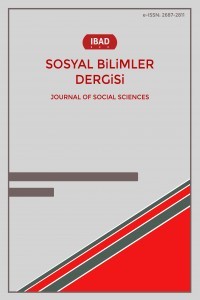Kültürlerarası Duyarlılık, Etnikmerkezcilik ve Sosyal Medya Kullanımı Etkileşimi
Bu çalışmanın amacı, kültürlerarası duyarlılık, etnikmerkezcilik ve sosyal medya kullanımı arasındaki ilişkilerin incelenmesidir. Bu amaçla, literatürde yer alan kültürlerarası duyarlılık, etnikmerkezcilik ve sosyal medya kullanımı ölçeklerinden yararlanılarak bir araştırma anketi oluşturulmuştur. Kolayda örnekleme yöntemi ile üç ayrı üniversitede okuyan ve ankete katılımı kabul eden 803 meslek yüksekokulu öğrencisine yüz yüze anket uygulanarak araştırma verisi toplanmıştır. Araştırma anketini oluşturan her bir ölçeğin, literatürdeki kullanımı araştırılmış ve ölçeklerle ilgili olarak güvenirlik analizleri ile doğrulayıcı faktör analizleri yapılmıştır. Ayrıca, araştırma hipotezlerini test etmek amacıyla, araştırma değişkenleri arasındaki etkileri ve ilişkileri gösteren regresyon analizi ile korelasyon analizi yapılmıştır. Elde edilen bulgulara göre, etnikmerkezcilik bağımlı değişkeninin sosyal medya kullanımı ve kültürlerarası farklılık alt boyutları ile % 46,3 oranında açıklanmıştır. Ayrıca, sosyal medya kullanımı için regresyon katsayısı (β= ,135; p
Anahtar Kelimeler:
Kültürlerarası Duyarlılık, Etnikmerkezcilik, Sosyal Medya Kullanımı
Intercultural Sensitivity, Ethnicity and Social Media Use Interaction
The aim of this study is to examine the relationships between intercultural sensitivity, ethnocentrism and social media use. For this purpose, a research questionnaire was created by using the scales of intercultural sensitivity, ethnocentrism and social media use in the literature. Survey data were collected by applying face-to-face questionnaires to 803 vocational school students who were studying at three different universities with the easy sampling method and accepted to participate in the survey. The use of each scale that constitutes the research questionnaire in the literature has been investigated, and reliability analyzes and confirmatory factor analyzes have been performed for the scales. In addition, in order to test the research hypotheses, correlation analysis with regression analysis showing the effects and relationships between research variables was performed. According to the findings, the ethnic centrism dependent variable was explained with the sub-dimensions of social media use and intercultural difference at a rate of 46.3%. In addition, since there is a regression coefficient for social media use (β =, 135; p
Keywords:
Intercultural Sensitivity, Ethnicity, Use of Social Media,
___
- Bulduk S, Tosun H, Ardıç E. (2011). Türkçe kültürler arası duyarlılık ölçeğinin hemşirelik öğrencilerinde ölçümsel özellikleri. Türkiye Klinikleri Journal of Medical Ethics-Law and History. 19 (1), 25-31.
- Chen, G., Starosta, W. (1996). Intercultural Communication Competence: A Synthesis. Communication Yearbook. ed. Brant B. Burleson. (19), 353-383. California: Sage Publications.
- Coffey,A.J., Kamhawi, R., Fishwick, P. and Julie Henderson, J. (2013). New Media Environments’ Comparative Effects Upon Intercultural Sensitivity: A Five-Dimensional Analysis, International Journal of Intercultural Relations, (37), 605-627.
- Fornell, C. And Larcker, D. (1981). Evaluating Structural Equation Models with Unobservable Variables and Measurement Error. Journal of Marketing Research, 18(1), 39-50.
- Fritz, W., Graf, A., Hentze, J., Mollenberg, A., and Chen, G. M. (2005). An examination of Chen and Starosta’s model of intercultural sensitivity in Germany and the United States. Intercultural Communication Studies, 14 (1), 53-65.
- Gerrit I. van Schalkwyk, Carla E. Marin, Mayra Ortiz, Max Rolison, Zheala Qayyum, James C. McPartland, Eli R. Lebowitz, Fred R. Volkmar, Wendy K. Silverman (2017). Social Media Use, Friendship Quality, and the Moderating Role of Anxiety in Adolescents with Autism Spectrum Disorder, J Autism Dev Disord, (47), 2805–2813.
- Guo-Ming, C., J.William Starosta, J.W. (2000). The Development and Validation of the Intercultural Sensitivity Scale, Annual Meeting of the National Communication Association, 86. Seattle, WA, November 8 (12), 4-5.
- Hair, J., Anderson, R.E. and Tapham, R.L. (1998). Multivariate data analysis. New York: Prentice Hall.
- Neuliep, J.W. and McCroskey, J. (1997). The Development of a U.S. and Generalized Ethnocentrism Scale. Communication Research Reports, 14 (4), 385-398.
- Neuliep, J. W., McCroskey, J. C. and Chaudoir.M. (2001). A Cross Cultural Comparison of Ethnocentrism Among Japanese and United States College Students. Communication Research Reports. 2 (18), 137-146.
- Olson, C. L. & Kroeger, K. R. (2001). Global Competency and Intercultural Sensitivity. Journal of Studies in International Education, (5), 116-137.
- Schermelleh-Engel, K., Moosbrugger, H. and Müller, H. (2003). Evaluating the fit of structural equation models: Tests of significance and descriptive goodness-off it measures, Methods of Psychological Research Online, (8), 23–74.
- Subrahmanyam, K. & Greenfield, P. (2008). Online communication and adolescent relationships, Future Child, 18(1), 119–146.
- Üstün, E. (2011). Öğretmen Adaylarının Kültürlerarası Duyarlılık ve Etnikmerkezcilik Düzeylerini Etkileyen Etmenler. Yayınlanmamış Yüksek Lisans Tezi. Yıldız Teknik Üniversitesi, İstanbul.
- Valkenburg, P. M. & Peter, J. (2007). Preadolescents’ and adolescents’ online communication and their closeness to friends, Developmental Psychology, 43 (2), 267–277.
- Yayın Aralığı: Yılda 2 Sayı
- Başlangıç: 2016
- Yayıncı: Hayrullah KAHYA
Sayıdaki Diğer Makaleler
Türkiye’de Fındık İhracatının Box-Jenkins Yöntemiyle Modellenmesi ve İhracat Öngörüsü
Yer Bağlılığının Sosyo-Mekânsal Farklar Bakımından İncelenmesi: Niğde Örneği
Mimari Tasarım Eğitiminde Biyomimikri ve Form İlişkisinin Kullanımı Üzerine Bir Literatür İncelemesi
Farklı Gelir Düzeyindeki Ülkelerde Ticari Açıklık, Finansal Gelişme Ve Ekonomik Büyüme İlişkisi
Şeyma YILMAZ KUŞÇUOĞLU, Zeki YILMAZ
İnovasyon Yönetiminin İşletme Performansina Etkisi: Dams Makine Örneği
Mustafa BAŞARAN, Mustafa EROL, Derya YILMAZ
Erkek Okul Öncesi Eğitimi Öğretmenlerinin Yaşadığı Mesleki Sorunlar
